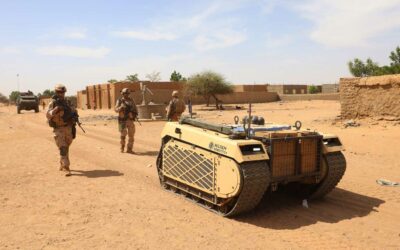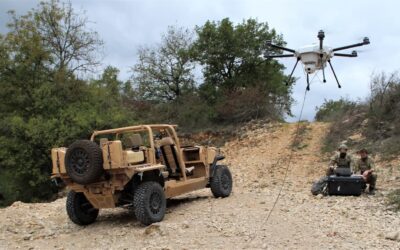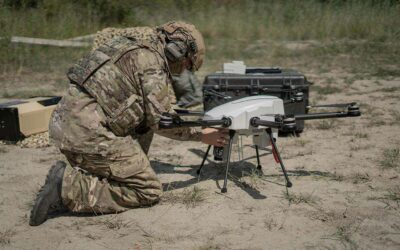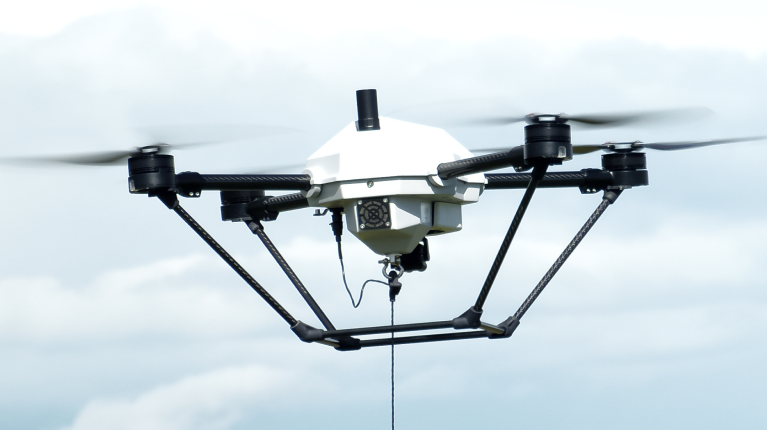Drones for Border Patrol – Enhancing Security with Tethered UAV Technology
David T. Daly
11 minutes
While it might seem hard to believe, militaries around the world have used drones for border safety for over one hundred years. Early military drones started appearing around 1916 in the form of radio-controlled monoplanes. Since that time, advancements in UAV technology have drastically improved the design and capabilities of drones.
When we think of drones for border patrol, we typically picture large military aircraft such as Northrop Grumman’s Global Hawk. These platforms play a key role in the military. However, they are not the best drones for every defense use of UAV technology. Numerous situations require similar capabilities, such as aerial surveillance; however, they are better suited for much smaller platforms.
One of the more recent advancements in the industry has been the introduction of tethered drone systems which are remarkably effective as drones for border patrol. Their capabilities to provide day-night surveillance are crucial to monitoring perimeters and tracking enemy movements
Types of Military Drones
Before getting into tethered drone systems, it is best to discuss the types of military drones briefly. Numerous ways to classify military drones exist. Countries worldwide rank their UAV platforms by weight, payload capability, range, mission type, and a slew of other criteria.
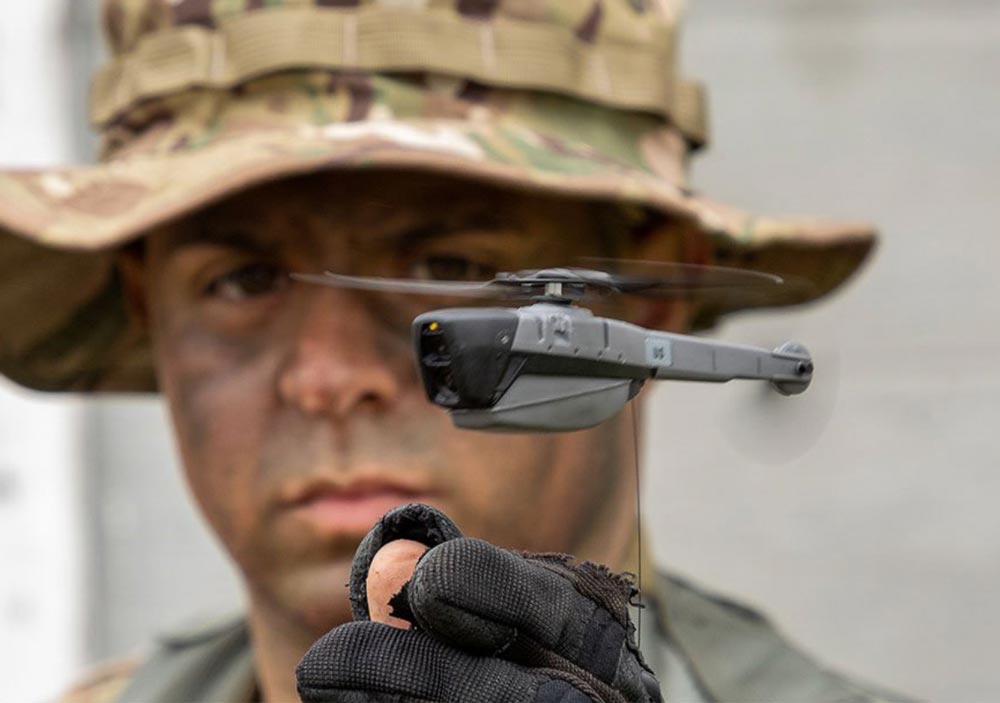
Micro or nano drones
Micro UAVs are typically hand-held military drones used at the squad level. They allow small groups of soldiers to see beyond their current position. However, they have limits on flight time and optics power.
The FLIR Black Hornet is typical of this drone class. This micro drone weighs less than 33 grams and has a maximum flight time of 25 minutes. The Black Hornet has a 2MP RGB camera and a 160×120 thermal camera. It can work up to 2km away from the operator.
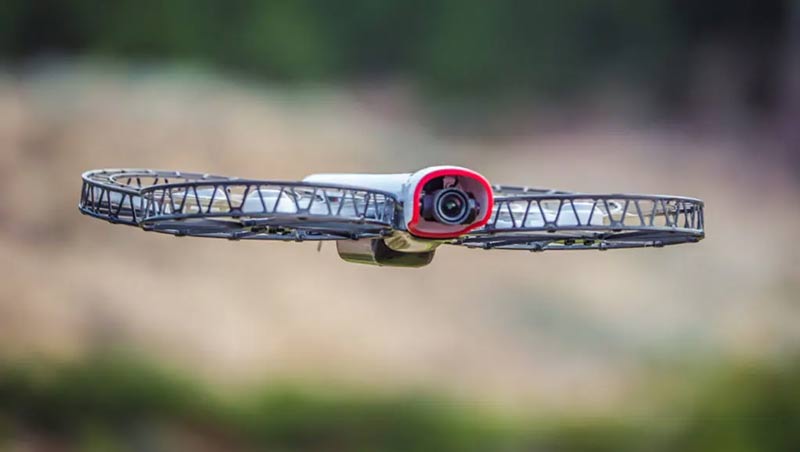
Short-range reconnaissance drones
These military drones are most often employed by squad to platoon level sized units. They are similar in capabilities to micro drones but have somewhat better optics and flight durations. Examples of drones in this category are the Parrot Anafi USA, Vantage Robotics’ Vesper, the Skydio X2-D, Teal Drones’ Golden Eagle, and Altavian’s M440 Ion.
The Parrot Anafi USA typifies the capabilities of drones in this class. With a weight of 500 grams, the Anafi USA has a maximum flight endurance of 32 minutes.
Like the Black Hornet, it has a dual camera but with much better resolution. The RGB camera can capture 21MP images and has a 32X zoom. The thermal camera has a resolution of 320×256, and the maximum flight range is 4km.
Mid-range reconnaissance drones
They are much larger than micro drones and short-range reconnaissance drones. The payloads of these drones have significantly better optics and with better range and flight durations. This class of military drones is an asset for company size units. UAVs in this class are great as drones for border patrol, and FOBs protection.
Drones in this group cover a wide range. At the low end, we have prosumer platforms like the DJI Phantom 4 series. At the high end, there are UAVs like AeroVironment’s Raven. Most tethered platforms, like Khronos DroneBox belong to this class of drones.

The Raven and the Elistair drones are great examples of untethered and tethered drones in the class.
The Raven can fly for 60 to 90 minutes and has a maximum range of 10 km. In contrast, the Khronos can fly for 24 hours and deploy from both moving and stationary vehicles.
One of the key advantage of these tethered systems is the secure data transmission through the tether, that hackers cannot breach.
Long range reconnaissance drones
Units employing long-range reconnaissance drones are at the battalion level or higher. The payloads for these platforms offer multiple optics and sometimes include weapon systems. Typically, these assets are ideal for theater-level operations and can travel for thousands of miles without refueling. The Global Hawk and General Atomics’ Predator are in this class of drones.
The Global Hawk weighs 32,250 pounds and has a range of 22,780km. Flying at a service ceiling of 60,000 feet, it is capable of flight times in excess of 32-hours.
Why Are Tethered UAVs Performant Drones for Border Patrol?
The different types of military drones give one an understanding of how prevalent UAVs are becoming for militaries worldwide. In general, larger drones run on aircraft fuel while the majority of smaller drones utilize LiPo batteries. The dependence on either fuel or batteries is a major limiting factor for platforms of all sizes.
Tethered drones address the limiting factor of power requirements. Tethered drone systems consist of 3 elements:
- The power station
Tethered drone stations are the tethered drone system’s foundation. They provide power, convert power, enable communications, and support tether winch operations for aircraft.
- The tether
The tether or cable is the connection between the drone and the station. They can be simple lines that keep the drone in place. They can also offer abilities that go beyond just holding the drone still. Industry-leading tethers include fiber optic cables, conductors, BPL lines allowing for dual-comms, and more.
- The aircraft
The drone is the final component of the tethered drone system. Capabilities vary between platforms, but most include imagery and communications equipment.
Tethered platforms are simple to use yet powerful: the base station receives power and then uses the cable to transfer power to the drone. The drone sends the data back to the base station through its tether. From there, it goes to collection and analyzing resources.
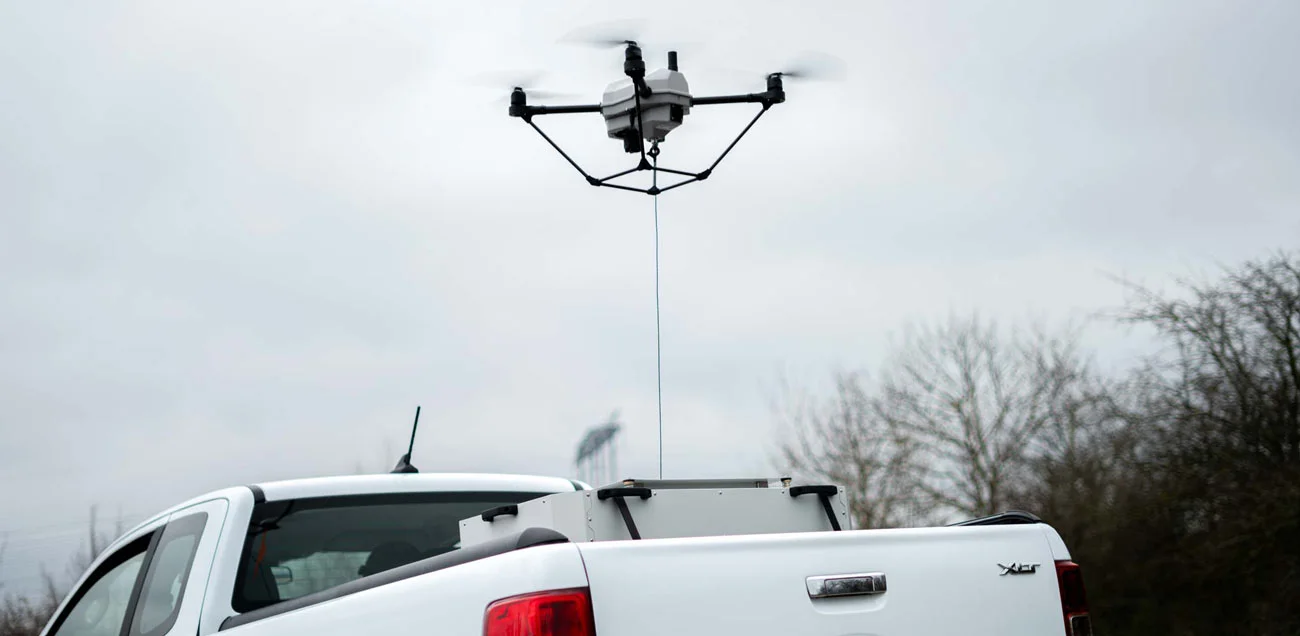
The Key Advantages of Tethered Drones
Tethered drones offer numerous benefits, especially when compared to untethered UAVs. As we will see, these benefits are characteristics sought after by any location looking for day-night surveillance capabilities.
- Unlimited Power
Flight times are measured in minutes for LiPo battery powered drones when they are measured in hours for tethered drones. Tethered drone stations typically connect to AC power, and converts it to DC. With power from the electric grid or a generator, the UAV has an almost limitless power source.
- Data security
Data collected by drones conducting aerial surveillance is sensitive in nature. Untethered drones must transmit their information wirelessly to pilots and operations centers opening the information up to hackers. Tethered drones use a the cable to transfer data, making them virtually hack-proof.
- Automated and safer flight
Pilots maneuvering drones while following a target face the challenging task of flying stable enough to produce reliable image capture. Tethered drones significantly reduce the effects of flying maneuvers on the videos and images collected by the UAV. Additionally, this means a pilot does not need to be highly proficient in maneuvering the military drone to accomplish the mission.
Tethered drones can be safer than untethered drones. The tether keeps the drone in a small area. This reduces the risk of damage to property and people. If the drone malfunctions and falls, like from a bird strike, the risk is lower.
Tethered Drones for Border Patrol and Other Military Applications
The benefits of tethered drones make the platform well suited for military use. Border surveillance, checkpoint security, entry/exit point monitoring, FOB security, and more require situational awareness and tactical communications. Let’s review in more detail some of these use cases.
Border patrol drones operations
Border control involves complex challenges. With many borders stretching for hundreds of miles, monitoring these boundaries requires enormous human resources. Obstacles like fences or walls are only as good as the assets watching them.
Tethered UAVs are easy to employ as drones for border patrol. Some of the best UAVs can detect vehicles many miles away. With an almost limitless power source, tethered drones can stay on station for hours, removing the need to land for fresh batteries. Patrols thus benefits from a constant day-night eye-in-the-sky.
Tethered drones for border patrol can be strategically positioned along a perimeter, working together as part of an integrated security system. This ensures overlapping surveillance coverage, with each unit enhancing situational awareness.
Furthermore, tethered Droneboxes can be integrated into patrol vehicles, extending coverage as the vehicle moves along the border. This mobile system can cover larger distances, delivering real-time ISR (Intelligence, Surveillance, and Reconnaissance) capabilities, including thermal imaging, object detection, and live video feeds. These functionalities enhance border patrol’s ability to detect, track, and respond to potential threats swiftly, even in remote or challenging terrain.
Forward Operating Base (FOB) Protection
As a former Marine, I have spent an extensive amount of time operating from FOBs in Iraq and Afghanistan. Through my experiences, I have learned that FOBs are problematic to defend. For starters, your enemy knows your exact location. They also get to choose when and how they will attack your position.
Guard towers, perimeter walls, and obstacles provide some distance. However, the enemy is often too close once they can see the guard towers.
Mounted cameras provide some protection but will not be able to see as far as aerial cameras. Tethered platforms can provide FOBs with constant surveillance at a considerable distance. More standoff means more time to prepare for an attack.
Manufacturers typically equip tethered drones with high-quality optics, able to spot vehicles or similar objects from 10 kilometers away. In addition, while static positions often lack beyond line-of-sight reconnaissance, tethered drones easily provide that capability.
Additionally, with virtually limitless flight times, tethered drones remain engaged and on station longer than personnel. Guard rotations are usually in 8-10-hour shifts. This allows for personnel to remain sharp and alert during the entire time they are work. Untethered drones in this class are not able to fly long enough to overlap guard rotations but tethered drones are.
Tactical Communications
Borders, FOBs, critical infrastructure, and other military installations are not only vulnerable to physical attacks. Cyberwarfare is becoming a significant concern. The hacking capabilities of some countries are becoming a powerful component of their military strategy.
Military drones use wireless communication, which can be hacked. Additionally, the field of counter-UAS technology is growing. Systems are in use that can jam drones and bring them down. The equipment needed to steal data from wireless drones is cheap and reliable.
Tethered drones are free from vulnerability to these types of cyberattacks and counter-UAS systems. The tether cable provides a tactical communications link. Friendly forces can operate the drone and transfer the data that the UAV collects without fearing compromise.
The cable allows for transfer speeds of 200mb/s all while maintaining secure communications.
As you can see, tethered drones are particularly advantageous as drones for border patrol and for Forward Operating Base (FOB) protection. Military drones are a powerful asset, but the limitations untethered drones have can leave critical areas vulnerable to coverage lapses or cyberattacks.
When planning for the protection of important static positions, consider tethered drone systems as a force multiplier.
Author – David T. Daly
For more information about Elistair and its products, please visit www.elistair.com and get the latest developments on Linkedin @elistair.

